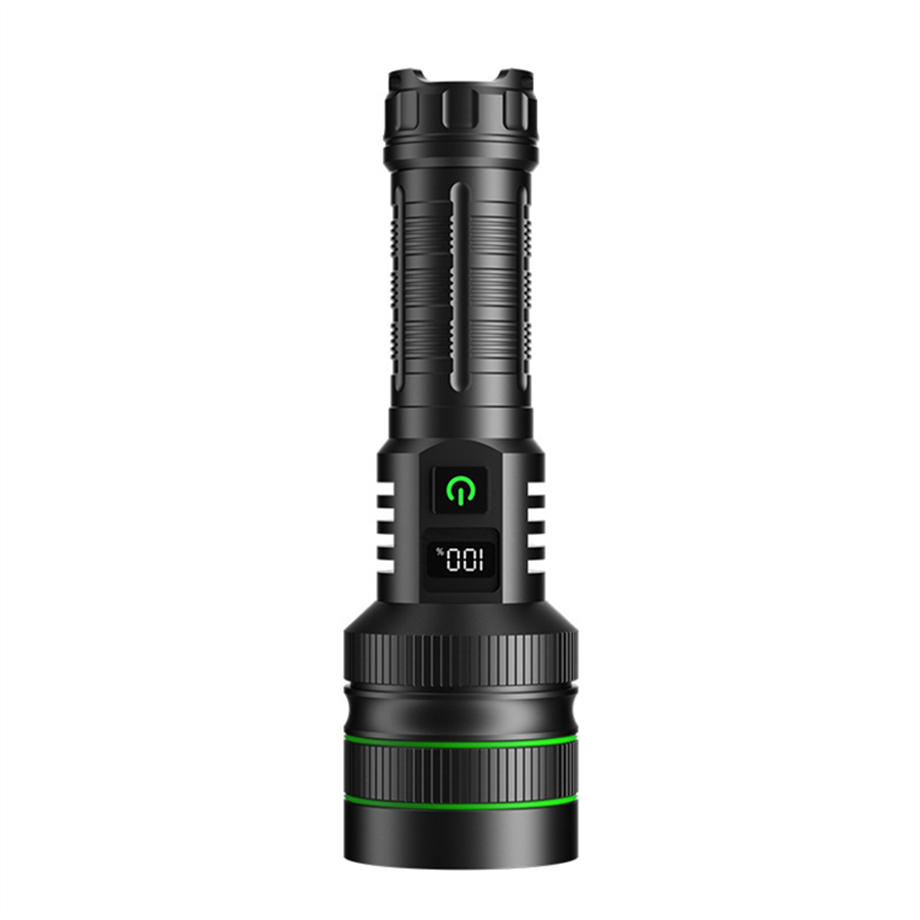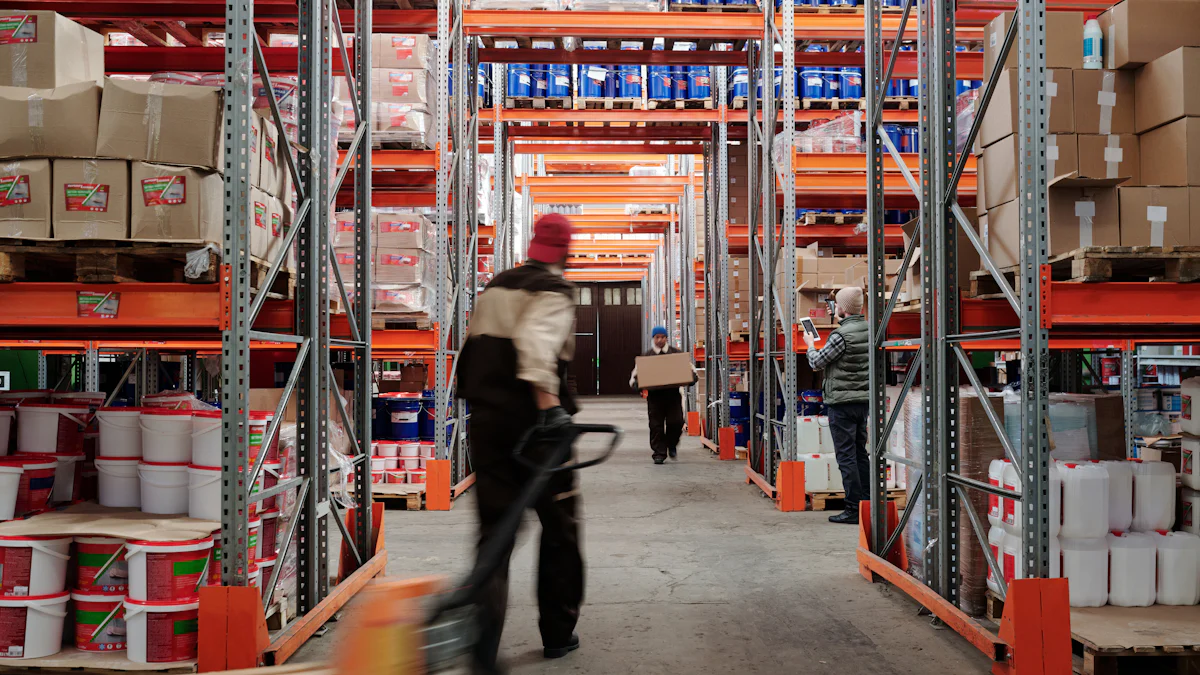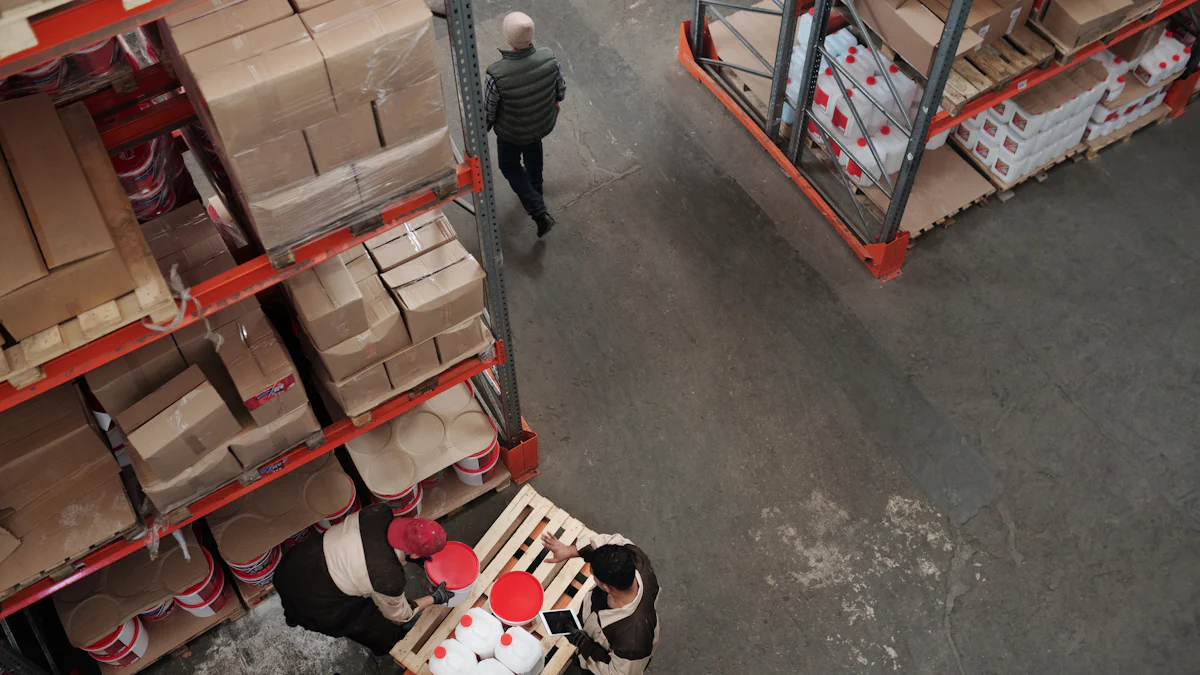Common Challenges in the Flashlight Supply Chain and How to Overcome Them

Supply chain challenges can disrupt your ability to deliver high-quality flashlights to customers. These disruptions often stem from material shortages, transportation delays, or outdated systems. Addressing these issues is critical to maintaining smooth operations and meeting customer expectations.
A recent survey highlights the widespread impact of supply chain challenges. For example, 54% of businesses report disruptions as a critical issue, while 52% struggle with running out of stock. These numbers show how common challenges in the flashlight supply chain and how to overcome them can directly affect your business. By tackling these obstacles, you can ensure consistent production, reduce costs, and build customer trust.
Key Takeaways
Lack of materials can stop production. Using many suppliers lowers risks and keeps parts available.
Tracking tools show supply chain problems quickly. They find delays and make customers happier.
Guessing demand correctly is very important. Using data tools and working with stores avoids too much or too little stock.
Expensive transport raises product prices. Better shipping routes and good delivery partners can cut costs.
New technology is important to use. Teaching your team and working with tech experts makes it easier and faster.
Material Shortages in the Flashlight Supply Chain

Root Causes of Material Shortages
Dependence on scarce raw materials
Flashlight production relies on specific raw materials like LEDs, lithium for batteries, and aluminum for casings. These materials often face global demand, making them scarce. When demand spikes, supply chain disruption becomes inevitable. For example, during the Russia-Ukraine War, key components like LEDs and batteries experienced temporary shortages. The conflict strained international logistics and disrupted production hubs in Eastern Europe. This highlighted the vulnerability of relying on limited resources and the need for local production to reduce supply chain risks.
Global sourcing disruptions
Global sourcing introduces challenges when disruptions occur. Events like natural disasters, geopolitical conflicts, or pandemics can halt the movement of materials. Supply chain disruptions often delay shipments and create bottlenecks. For flashlight manufacturers, this means production halts and missed deadlines. The interconnected nature of global trade amplifies the impact of even minor disruptions, making it essential to address these risks proactively.
Impact of Material Shortages
Delays in production timelines
Material shortages directly affect your production schedules. Without essential components, assembly lines stop, and delivery timelines extend. This disruption can lead to dissatisfied customers and lost revenue. For businesses, delays also mean increased operational costs as you scramble to find alternative solutions.
Increased costs for alternative sourcing
When shortages occur, sourcing materials from alternative suppliers becomes necessary. However, this often comes at a higher cost. Emergency procurement strategies, expedited shipping, and premium pricing for scarce materials can strain your budget. These rising costs ultimately impact your profit margins and product pricing.
Overcoming Material Shortages
Building diverse supplier networks
Diversifying your supplier base reduces dependency on a single source. By working with multiple suppliers across different regions, you can mitigate the risks of supply chain disruption. This approach ensures that if one supplier faces challenges, others can fill the gap. Building strong relationships with suppliers also fosters better communication and reliability during disruptions.
Exploring sustainable material options
Sustainable materials offer a long-term solution to material shortages. Many flashlight manufacturers are now exploring alternatives like recycled plastics, bio-based polymers, and bamboo-derived components. These materials not only reduce reliance on scarce resources but also align with growing consumer demand for eco-friendly products. By adopting sustainable practices, you can future-proof your supply chain and reduce environmental impact.
Supply Chain Visibility Challenges
Causes of Limited Visibility
Fragmented supplier and manufacturer data
Fragmented data across suppliers and manufacturers creates significant challenges in supply chain management. When data is stored in silos, it becomes difficult to access and share critical information. This lack of integration disrupts communication and leads to inefficiencies. For flashlight manufacturers, fragmented data can delay decision-making and increase the risk of supply chain disruption. Without a unified system, you may struggle to identify bottlenecks or predict potential disruptions.
Outdated tracking and monitoring systems
Outdated systems further limit supply chain visibility. These legacy technologies often fail to support real-time data exchange, which is essential for modern supply chain efficiency. They also contribute to operational challenges by creating gaps in visibility. For example:
Data silos hinder the flow of information across the supply chain.
Inefficient communication increases the likelihood of human error.
Limited adaptability to current demands reduces your ability to respond to disruptions effectively.
Effects of Poor Visibility
Difficulty in identifying and resolving bottlenecks
Limited visibility makes it harder to pinpoint bottlenecks in your supply chain. Without clear insights, you may not detect where delays or inefficiencies occur. This lack of clarity can slow down production and delivery, ultimately affecting customer satisfaction. Identifying bottlenecks quickly is crucial for maintaining supply chain efficiency.
Reduced agility in responding to supply chain disruption
Poor visibility reduces your ability to adapt to supply chain disruptions. When you cannot track shipments or monitor inventory levels in real time, responding to unexpected events becomes challenging. This lack of agility can lead to missed opportunities to mitigate supply chain risks, further compounding the disruption.
Enhancing Supply Chain Visibility
Adopting real-time tracking technologies
Real-time tracking technologies offer effective solutions to visibility challenges. These tools provide live updates on shipments, inventory, and production processes. The benefits include:
Benefit | Description |
|---|---|
Increased Efficiency | Companies can identify key problem points in their supply chain, leading to better operations. |
Identification of Delays | Live tracking helps pinpoint areas where delays occur, allowing for route reconfiguration. |
Improved On-Time Performance | Certain industries report up to a 60% increase in on-time deliveries with real-time tracking. |
Reduction of Theft | Tracking helps identify weak points in security and recover missing items more effectively. |
Increased Transparency | Modern consumers expect full transparency in the supply chain process. |
Improved Customer Satisfaction | Enhanced tracking leads to higher customer satisfaction and loyalty, reducing churn. |
By adopting these technologies, you can improve supply chain efficiency and reduce the impact of disruptions.
Centralizing data with advanced supply chain software
Centralized data systems streamline supply chain management. Advanced software integrates information from suppliers, manufacturers, and logistics providers into a single platform. This approach eliminates data silos and enhances visibility across the entire supply chain. With centralized data, you can monitor operations in real time, identify bottlenecks, and respond to disruptions more effectively. These solutions not only improve efficiency but also reduce supply chain risks.
Demand Forecasting Challenges
Why Demand Forecasting is Difficult
Volatile consumer demand patterns
Consumer demand for flashlights often fluctuates due to seasonal trends, emergencies, or new product launches. For example, demand may spike during natural disasters or power outages but drop during stable periods. These unpredictable patterns make it challenging to forecast accurately. Additionally, competition from inferior lighting devices and misconceptions about flashlight costs further complicate demand forecasting. You must account for these variables to avoid errors in planning.
Inaccurate or incomplete historical data
Historical data plays a crucial role in predicting future demand. However, incomplete or outdated data can lead to inaccurate forecasts. Limited consumer awareness of modern flashlight technology and the need for ongoing innovation add to the complexity. Without reliable data, you risk making decisions that could disrupt inventory management and reduce efficiency.
Consequences of Forecasting Errors
Overstocking or understocking inventory
Errors in forecasting can result in overstocking or understocking. Both scenarios have significant financial implications:
Understocking leads to stockouts, causing lost sales as customers turn to competitors.
Overstocking ties up cash and requires additional storage space, increasing costs.
Implication | Overstocking | Understocking |
|---|---|---|
Financial Strain | Ties up cash that could be used elsewhere | Results in missed revenue opportunities |
Storage Issues | Requires more storage space, increasing costs | Disrupts efficient warehouse operations |
Customer Satisfaction | Can lead to discounted excess inventory | Causes customer frustration and loss of trust |
Operational Inefficiencies | Leads to inefficiencies in inventory management | Skews inventory data and complicates forecasting |
Increased operational inefficiencies
Forecasting errors disrupt inventory management and reduce efficiency. Understocking forces you to expedite shipments or find alternative suppliers, increasing operational costs. Overstocking, on the other hand, creates inefficiencies in managing excess inventory. Both scenarios hinder your ability to maintain a streamlined supply chain.
Improving Demand Forecasting
Leveraging predictive analytics and AI tools
Predictive analytics and AI tools offer effective solutions for improving demand forecasting. These technologies analyze historical data, market trends, and consumer behavior to provide accurate predictions. By using these tools, you can enhance efficiency, reduce shortages, and optimize inventory management. Many flashlight manufacturers have already adopted AI-driven solutions to stay competitive.
Collaborating with retailers for real-time insights
Collaboration with retailers provides valuable real-time insights into consumer demand. Retailers can share data on sales trends, customer preferences, and inventory levels. This partnership helps you adjust production and inventory strategies to meet actual demand. Real-time insights also improve efficiency by reducing the risk of shortages or overstocking.
Rising Transportation Costs in the Supply Chain

Transportation and freight costs have become a significant concern for flashlight manufacturers. These costs directly impact your bottom line and influence product pricing. Understanding the key drivers of these expenses and adopting strategies to mitigate them can help you navigate supply chain disruption effectively.
Key Drivers of Transportation Costs
Fluctuating fuel prices
Fuel prices often fluctuate due to global economic conditions, geopolitical tensions, and natural disasters. These changes increase the cost of moving goods across regions. For flashlight manufacturers, higher fuel prices mean higher logistics expenses, which can strain your budget.
Shortages of shipping containers and logistics resources
Shipping bottlenecks caused by container shortages and limited logistics resources create additional challenges. These shortages often result from supply chain disruptions, such as port congestion or labor strikes. When containers are unavailable, transportation costs rise due to increased demand for limited resources.
Impact of High Transportation Costs
Increased product prices for consumers
Higher transportation and freight costs often lead to increased product prices. You may need to pass these costs on to consumers, which can reduce demand for your products. This price increase can also affect your competitiveness in the market.
Reduced profit margins for manufacturers
Rising transportation costs directly reduce your profit margins. When you absorb these expenses instead of passing them on to customers, your profitability suffers. This financial strain can limit your ability to invest in innovation or expand your operations.
Strategies to Mitigate Transportation Costs
Optimizing shipping routes and schedules
Route optimization minimizes transportation costs by reducing fuel consumption and delivery times. Advanced logistics software can help you identify the most efficient routes and schedules. This approach not only lowers costs but also improves delivery reliability, reducing the risk of supply chain disruption.
Partnering with cost-efficient logistics providers
Collaborating with reliable logistics providers can help you manage transportation expenses. Look for partners who offer competitive rates and have a proven track record of handling supply chain risks. Strong partnerships ensure smoother operations and reduce the impact of disruptions on your supply chain.
Tip: Regularly review your logistics strategy to identify areas for improvement. Small adjustments can lead to significant cost savings over time.
Technology Integration Challenges
Barriers to Technology Adoption
High initial investment costs
Adopting new technologies often requires significant upfront costs. Purchasing advanced supply chain management tools, upgrading hardware, and implementing software solutions can strain your budget. These expenses may seem overwhelming, especially for small or medium-sized flashlight manufacturers. However, delaying these investments can lead to long-term inefficiencies and missed opportunities for growth.
Resistance to change within organizations
Resistance to change is another common barrier. Employees may feel hesitant to adopt new systems due to unfamiliarity or fear of job displacement. This reluctance can slow down the integration process and reduce the effectiveness of new technologies. Without proper training and communication, your team may struggle to adapt, creating further challenges in your supply chain management.
Consequences of Outdated Systems
Reduced operational efficiency and scalability
Outdated systems limit your ability to operate efficiently. Manual processes and legacy software often lead to errors, delays, and wasted resources. These inefficiencies can hinder your ability to scale operations as demand grows. Modern supply chain management requires tools that streamline processes and improve efficiency across all levels.
Increased vulnerability to supply chain disruption
Old systems make your supply chain more vulnerable to disruption. Without real-time tracking or predictive analytics, you may struggle to respond to unexpected events. This lack of adaptability can lead to delays, lost revenue, and dissatisfied customers. Staying competitive requires systems that enhance visibility and resilience.
Solutions for Technology Integration
Training teams on new systems and processes
Training your team is essential for successful technology adoption. Provide hands-on workshops and ongoing support to help employees understand new tools. When your team feels confident using these systems, they can work more efficiently and embrace the changes. This approach reduces resistance and ensures smoother integration.
Partnering with technology providers for tailored solutions
Collaborating with technology providers can simplify the integration process. These experts can assess your specific needs and recommend solutions that align with your goals. Tailored solutions ensure that your investment delivers maximum value. By working with experienced providers, you can address challenges effectively and future-proof your supply chain.
Tip: Start small by implementing one technology at a time. Gradual adoption allows your team to adjust and minimizes disruption to daily operations.
Supply chain challenges, such as material shortages, high transportation costs, and outdated systems, can disrupt your operations. These issues, combined with fluctuating raw material prices and the high costs of advanced flashlight models, make it harder to stay competitive. Proactive strategies like diversifying suppliers, adopting real-time tracking, and leveraging predictive analytics can help you overcome these obstacles. By addressing these challenges head-on, you can ensure resilience and meet customer expectations. Embracing innovative solutions will also position your business for long-term success in a competitive market.
FAQ
What are the most common supply chain challenges for flashlight manufacturers?
You often face material shortages, high transportation costs, and outdated systems. These issues disrupt production and delivery. Addressing them with proactive strategies like diversifying suppliers and adopting technology ensures smoother operations.
How can you improve demand forecasting for flashlights?
Use predictive analytics and AI tools to analyze trends and consumer behavior. Collaborate with retailers for real-time sales data. These methods help you predict demand accurately and avoid overstocking or understocking.
Why is supply chain visibility important?
Visibility helps you identify bottlenecks and respond to disruptions quickly. Real-time tracking and centralized data systems improve efficiency and reduce risks. Without visibility, you may struggle to maintain smooth operations.
What sustainable materials can replace traditional flashlight components?
You can explore recycled plastics, bio-based polymers, or bamboo-derived materials. These options reduce reliance on scarce resources and align with eco-conscious consumer preferences.
How do rising transportation costs affect flashlight pricing?
Higher transportation costs increase product prices or reduce profit margins. Optimizing shipping routes and partnering with cost-efficient logistics providers can help you manage these expenses effectively.
See Also
Essential Factors to Consider When Choosing Flashlight Suppliers
Guidelines for Finding Trustworthy Wholesale Flashlight Suppliers
My Journey to Discovering Dependable Wholesale Flashlight Suppliers
